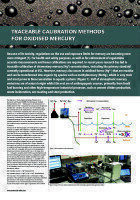Air Monitoring
Traceable calibration methods for oxidised mercury
Jul 04 2019
Author: Iris de Krom on behalf of VSL Dutch Metrology Institute
Because of its toxicity, regulations on the use and exposure limits for mercury are becoming even more stringent. For health and safety purposes, as well as for enforcement of regulations accurate measurements and hence calibrations are required. In recent years research has led to traceable calibration of elementary mercury (Hg0) concentrations, including the primary standard currently operational at VSL. However, mercury also occurs in oxidised forms (Hg2+) that are reactive and can be transformed into organic Hg species such as methylmercury (MeHg), which is very toxic and most prone to bioaccumulation in aquatic systems (Figure 1). Half of atmospheric mercury emissions are of natural origin whilst the rest are of anthropogenic sources, primarily from fossil fuel burning and other high-temperature industrial processes, such as cement clinker production, waste incineration, ore roasting and steel production.
Digital Edition
AET 28.2 April/May 2024
May 2024
Business News - Teledyne Marine expands with the acquisition of Valeport - Signal partners with gas analysis experts in Korea Air Monitoring - Continuous Fine Particulate Emission Monitor...
View all digital editions
Events
Jul 30 2024 Jakarta, Indonesia
China Energy Summit & Exhibition
Jul 31 2024 Beijing, China
2024 Beijing International Coal & Mining Exhibition
Aug 07 2024 Beijing, China
IWA World Water Congress & Exhibition
Aug 11 2024 Toronto, Canada
Aug 25 2024 Stockholm, Sweden and online






.jpg)








